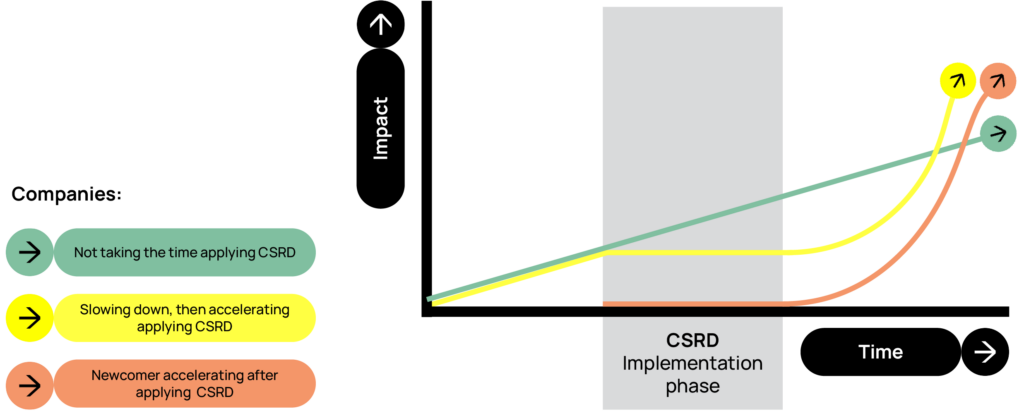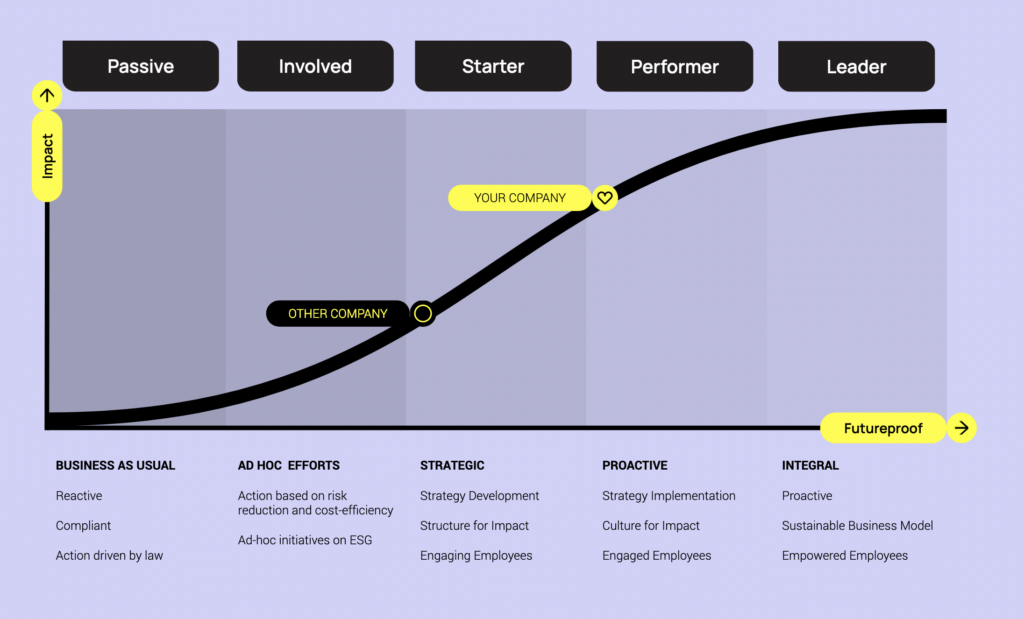CSRD: Slowing down impact -or- accelerating sustainable business?

As sustainability professionals, we’re driven by the desire to make a real impact. But with the introduction of the Corporate Sustainability Reporting Directive (CSRD), many of us feel a sense of dread. Is this just another bureaucratic hurdle? I was skeptical too, but I’ve seen CSRD as a powerful tool for amplifying our impact. Let me take you on my journey of discovery.
01
The CSRD Challenge
When CSRD first landed on my desk, I felt overwhelmed. Another reporting requirement? How would this help us create real change? The questions seemed endless:
These concerns are valid, but as I’ve learned, they’re also disguised opportunities.
02
The Silver Lining for Sustainability Newcomers
For companies just starting their sustainability journey, CSRD is an accelerator. It provides a structured approach to kickstart sustainability efforts, offering a clear framework for what to measure and report. And from there on out start integrating sustainability in the business model, while addressing the impacts, risks and opportunities uncovered in the process. In essence, it’s an extensive starting point for sustainability newcomers.
03
The Sustainability Veteran’s Dilemma
But what about those of us already deep in the sustainability trenches? At first, CSRD can feel like a speed bump when you want to accelerate on your impact. The urgency of climate change and social issues in the value chain made this new reporting requirement feel like a distraction.
However, I’ve come to realize that this apparent slowdown is actually a chance to ensure our clients are moving in the right direction.
04
Reframing CSRD: From Burden to Benefit
This shift in perspective reminds me of a profound quote by Abraham Lincoln:
Give me six hours to chop down a tree and I will spend the first four sharpening the axe.
This wisdom applies perfectly to our CSRD journey. While it might feel like we’re slowing down initially, we’re actually sharpening our sustainability ‘axe’. By investing time in understanding and implementing CSRD, we’re honing our ability to create lasting impact.
CSRD forces you to focus on what truly matters. It’s not just about ticking boxes; it’s about deeply understanding our organization’s sustainability landscape. This focused approach allows you to:
05
While CSRD might seem daunting, breaking it down into actionable steps can make the process more manageable and even exciting. Here’s a roadmap to get you started:
- Create a project team: Assemble a cross-functional team that brings diverse perspectives and expertise.
- Determine key stakeholders: Identify and engage all relevant parties within your company. This will likely include finance, operations, HR, and top management.
- Set the scope: Clearly define what aspects of your business will be covered under CSRD reporting.
- Develop a plan and roadmap: Create a timeline with key milestones and deliverables.
- Align with your accountant: Ensure your CSRD reporting will meet all necessary financial and audit requirements.
- Begin your Double Materiality Assessment (DMA): This crucial step helps you identify the sustainability topics that are most relevant to your business and stakeholders.
By following these steps, you’re not just complying with CSRD – you’re laying the groundwork for a more sustainable and impactful business. There is of course more to it, but this way you can get started.
06
Amplifying Impact Through Focus
Initially, CSRD may slow you down. But this deliberate pace allows you to focus on the right topics and measure the things that truly matter. By forcing us to take a comprehensive look at our sustainability efforts, CSRD helps us identify where we can make the most significant impact, here is how it helps;

- Materiality Assessment: CSRD requires a thorough evaluation of sustainability issues most relevant to our business and stakeholders. This often reveals surprising insights, helping you address the most pressing concerns for your business and society.
- Data-Driven Decision Making: CSRD’s rigorous reporting requirements push us to collect and analyze more comprehensive sustainability data. This wealth of information enables more informed strategic decisions, better resource allocation, and more accurate progress tracking.
- Holistic View of Sustainability: CSRD encourages us to look at sustainability from multiple angles. This helps you identify synergies, recognize potential trade-offs, and develop more comprehensive sustainability strategies.
- Stakeholder Engagement: The focused approach required by CSRD leads to more meaningful stakeholder engagement. You’re compelled to consult with a wider range of stakeholders, engage in more substantive discussions, and build stronger relationships.
- Long-Term Perspective: CSRD’s comprehensive nature encourages us to think beyond short-term gains and consider the long-term implications of our actions. This allows you to develop more ambitious sustainability goals, invest in initiatives with significant long-term impact, and build resilience into our business model.
In essence, while CSRD may seem to slow you down at first, it’s actually helping you speed up in the right direction.
07
Leveraging CSRD for Comprehensive ESG Management
CSRD is a powerful tool for uncovering hidden risks and opportunities in your sustainability efforts. Here’s how it helps you manage ESG comprehensively:
- Uncovering Hidden Risks and Opportunities:
- Climate Risks in Supply Chains: CSRD helps you identify vulnerabilities due to climate change, such as disruptions from extreme weather events or resource scarcity.
- Transitional Risks of Logistical Partners: It highlights potential risks associated with partners who may not be adapting quickly enough to a low-carbon economy.
- Reputational Risks in the Value Chain: CSRD’s focus on the entire value chain helps you proactively manage risks related to worker misconduct, even in distant parts of the supply chain.
- Integrating CSRD into Decision-Making:
- Risk Mitigation Strategies: Develop targeted strategies to address identified risks, like diversifying suppliers or investing in climate-resilient infrastructure.
- Opportunity Mapping: Use CSRD insights to identify new business opportunities, such as developing sustainable products or services.
- Stakeholder Engagement: Leverage CSRD data to enhance communication with your investors, customers, and employees about sustainability efforts.
- Strategic Planning: Integrate ESG considerations unveiled by CSRD into your long-term business strategy.
- Case Study: Refocusing for True Sustainability A retail partner initially confident in their sustainability efforts discovered through CSRD that their impact needed significant improvement. This revelation led to:
- Refocusing sustainability efforts on areas of greatest impact
- Developing more comprehensive sustainability goals
- Implementing better monitoring and adjustment processes
- The result: A path to creating truly sustainable products and operations, making a real, measurable impact.
CSRD doesn’t just help you report better; it helps you do better. By providing a comprehensive view of your ESG landscape, it enables you to make more informed decisions, manage risks more effectively, and create more impactful sustainability strategies.
08
CSRD as a Catalyst for Sustainability Maturity
CSRD isn’t just about reporting – it’s a powerful tool for driving sustainability maturity within your organization. By implementing CSRD, you’re:
- Creating a comprehensive sustainability framework
- Integrating sustainability into core business processes
- Elevating sustainability discussions to the board level
- Uncovering new opportunities for innovation and growth
Imagine the possibilities: As your organization climbs the sustainability maturity scale, you’ll be better positioned to create meaningful impact, attract top talent, and build resilience for the future.

Conclusion
While CSRD may initially feel like a drag on our sustainability efforts, it has the potential to be a powerful ally in our quest for impact. By embracing this framework, we can sharpen our focus, uncover new opportunities, and ultimately amplify our positive influence on the world.
Yes, it will slow us down initially. But by forcing us to focus on the right topics and measure the right things, CSRD can potentially amplify our impact exponentially. It allows us to work better on what truly matters, making more significant and lasting impact in the long run.
So, fellow sustainability professionals, let’s embrace CSRD not as a burden, but as a powerful tool in our sustainability arsenal. It’s time to sharpen our axes and prepare for the impactful work ahead. The future of sustainable business is here, and with CSRD, we’re better equipped than ever to shape it.